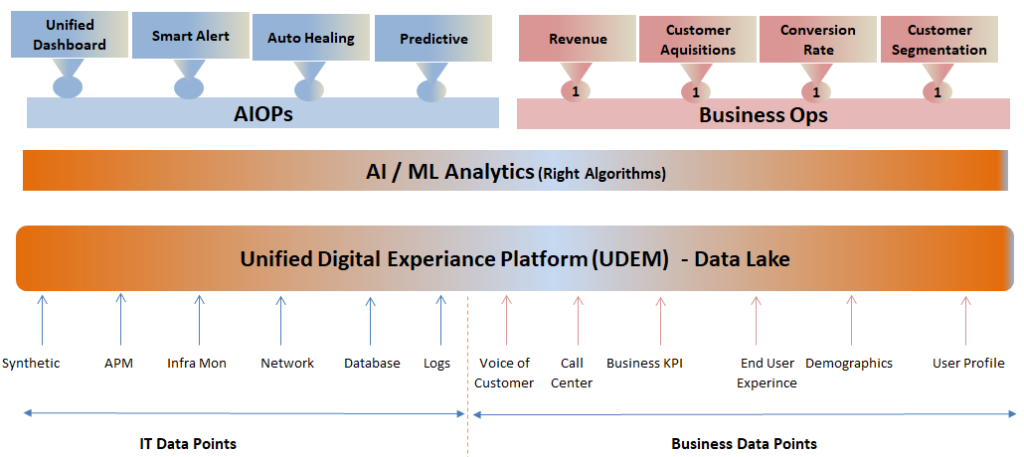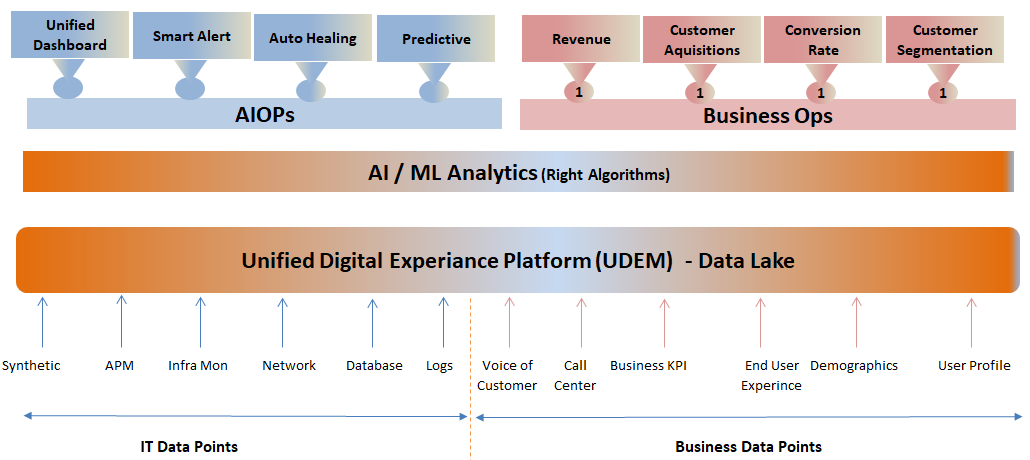Unified Digital Experience Management Platform (UDEM) where AIOPs meets BizOps
By, Nilesh Hase , Head of Innovation – QualityKiosk Technologies.
In Today’s age, Digital Transformation is the need of the hour. It is happening at a very brisk rate. This, however, has brought up a new challenge – managing the Customer Experience. Everyone in Organisation, the Business, the IT, or the Operations, should now have a single point agenda – drive a delightful customer experience. They should work collaboratively towards it by breaking the silos.
According to Gartner’s assumption, by the end of 2020, approximately 50% of enterprises will actively use AIOps technologies together with APM to provide insight into both business execution and IT operations, up from fewer than 10% today.
Key Challenges faced by Organisations in current scenario
IT and operations leaders use various tools such as APM, Server, Network, and Infra monitoring to provide real-time surveillance of business-critical applications. While these tools are effective in detecting well-known IT problems, they can’t correlate them with the context of a business process.
As a result, business stakeholders cannot effectively utilize the information provided by these tools to gain insight to guide business decisions. This is a waste of resources that otherwise would be used to help grow the business — an effort that fails to deliver.
The major cause of this limitations are
▪ Silos across departments
IT & Operations: Typically, IT manages key KPIs such as application performance, network performance, database, logs, server, firewall, etc. Every KPI is handled by different teams.
Business & IT: Most of the current APM tools deliver advice with limited business context. This leaves the I&O leaders without a way to connect APM output to business outcomes such as improved revenue, customer acquisitions, conversion rates, voice of customer, CLV, risk and cost.
▪ Many monitoring tools only focus on providing diagnostics for incidents in the past, and do not provide sufficient assistance in predicting occurrences which can cause an impact in the future.
▪ I&O leaders struggle to detect the business context of anomalies, trends and patterns in monitoring data without data science and business analytics expertise.
▪ People and Processes: People change over a period of time – they move out or take different roles. ITOps experts might get into Devops, database experts may move into data science, developers would go towards automation, and people influence the process. With people, the knowledge and expertise goes out of the organization.
QK’s UDEM Platform: A one stop solution to counter the above challenges

We, at QualityKiosk, have envisioned and developed a Unified Digital Experience Management (UDEM) platform, based on a central data lake hosted on big data platform such as MongoDB, where you can put all the Business and IT data together, irrespective of it being structured or unstructured, and apply the right AI algorithms to derive significant business insights, patterns, correlations out of it. The above is a schematic diagram of the same.
This platform is based on a central repository driven by AI which maintains, learns from it, and keeps improving over the period to deliver key insights prediction to stop outages by predicting anomalies proactively.
The platform maps application performance metrics to business objectives by collaborating with business leaders to determine what to measure and by using AIOps to detect unsuspected dependencies.
It expands the ability to support prediction by using AIOps to forecast high probability future problems. It provides insight into future events using its ability to extrapolate what is likely to happen next. Its machine learning algorithms deliver probability-based awareness of what is yet to come. This enables I&O leaders to take action in order to prevent impact. The results of these algorithms are validated over time to test the reliability of their forecasts.
With the right machine learning algorithms such as Holt-Winters and Naïve Bayes , UDEM provides value: predicting trends, detecting anomalies, determining causality and classifying data. This also helps in analyzing streaming data and predicting user sentiment. It improves business outcomes leading to enhanced revenue, cost and risk by applying AIOps machine learning algorithms to customer and transaction data.
A plausible real life scenario
QualityKiosk’s UDEM with its pattern recognition, advanced analytics and machine learning capabilities, can extend APM’s historical insight into application availability and performance to provide business impact.
For example, adding customer sentiment data and related data from the service desk into user experience measurement can provide a more accurate customer satisfaction estimation than the APM-only solution of feeding response time or page load time data into an Apdex algorithm. With the APM-only approach, I&O leaders might come to the erroneous conclusion that their customers are delighted based on fast page load times. However, by ingesting data from social media and using AIOps to analyze page load and sentiment, they can learn that pages, while loading fast, have unhelpful information or high prices, and that customers are not delighted. In fact, it is quite the opposite.
This example can be further enriched by augmenting the two data streams mentioned above with additional data from order management and customer service applications. This can be used to provide an effective measurement of the relationship between IT metrics and the accomplishment of business objectives such as increased revenue and greater customer satisfaction.
I&O leaders can benefit greatly from AIOps capabilities working in conjunction with an APM solution. Specifically, the IT folks will benefit with the usage of machine learning capabilities, including anomaly detection, classification, clustering and extrapolation. These machine learning technologies can be used to analyze behavior such as examining the actions of users during the order process and relating that behavior to events afflicting the underlying IT infrastructure.
Clustering, together with classification and extrapolation, could be used to segment users on the basis of their behavioral patterns and predict their future buying activities. I&O leaders can provide this analysis on a self-service dashboard for the business to use.
Key Takeaways
To keep up with the upcoming trends and be a pioneer in their respective fields, the organisations should
● Collect the list of mission-critical priorities of the business relative to applications by collaborating with the business.
● Acquire the data supporting the measurement of selected business objectives by capturing the flow of IT activities
● Collect and store all the data into a big data platform which will help them to retain data for a long time (required for AI to learn)
● Use AIOps algorithms to detect patterns or clusters in the combined business and IT data, infer relationships, and determine causality.
● Create a model that relates algorithm-determined relationships as well as human-specified ones with prioritized business objectives.
Having this model in place, it can be used to predict future values of time-series data such as end-user response time, engage in root-cause analysis of predicted issues to determine the true fault, and take preventative measures to prevent the impact of predicted problems.
The Future Perspective
This model can be further refined based on observations and evaluation of its accuracy to establish how changes in application performance and availability impact customer sentiment and company reputation.
It can further be used to investigate the relationships between sequences of IT interactions such as those that model a business process (e.g., a customer journey) and business outcomes.
Welcome to the future! We at QualityKiosk can help you keep pace with it.
Drop in a mail at info@qualitykiosk.com for a live demo and consultation.
